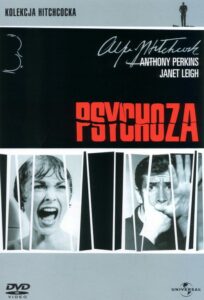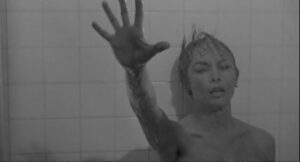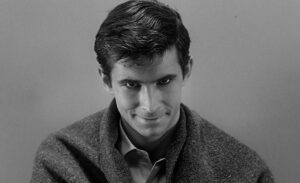“Psycho” – Freudianism according to Hitchcock

Title: “Psycho”
Release Date: 1960
Director: Alfred Hitchcock
Cast: Anthony Perkins, Vera Miles, Janet Leigh, Martin Balsam, John McIntire, Simon Oakland, Vaughn Taylor, Lurene Tuttle
In “Psycho”, Alfred Hitchcock rose to the heights of his directorial talent. As a result, the film crosses the boundaries of the genre, and instead of a simple thriller story, we have a picture that puts the viewer eye to eye with his own innermost fears.
“Psycho” – what is the film about?
“Psycho” is one of Hitchcock’s most outstanding movies. It was made in 1960 and can still surprise the viewer. However, it’s not so much about the plot, which, more or less from the middle of the film, is quite schematic, but about the emotions that the film evokes in the viewer. After all, Psycho seems to tease deep layers of the human unconscious, and the director plants doubt in the viewer about his own inner conflicts.
The movie tells the story of a young secretary, Marion Crane (played by Janet Leigh), who embezzles $40,000 in cash with the thought of her beloved Sam (John Gavin) plunged into debt. During her escape, she strays off the highway and ends up at a lonely motel, where she decides to spend the night, much to the delight of the boarding house’s young owner, Norman Bates (Anthony Perkins). Nevertheless, while bathing, Marion is bestially murdered. The girl’s trail is set off by her sister Lili (Vera Miles), along with Sam and a private detective (Martin Balsam).

The latter is also murdered in the motel, and the other two heroes unsuccessfully seek help from the local sheriff. Eventually the two go to the motel, where they are attacked by Norman in a woman’s disguise. In the final scene, a psychiatrist explains that the man first murdered his mother and her partner and then descended into madness. He murdered attractive women staying at the boarding house, convinced that she was his mother.
It’s worth mentioning that the plot of “Psycho” was to some extent inspired by the real-life story of Ed Gein, a murderer in the 1940s who began killing after his mother died and hid her corpse in the basement.
“Psycho” and the mastery of horror aesthetics
“Psycho” is a film that captivates the viewer with the refinement of the smallest details, which work extremely evocatively on the reception of this work. Attention is drawn to Norman Bates’ gloomy house, straight out of Fritz Lang’s Gothic aesthetics. Of particular interest are the stuffed birds in the boarding house owner’s living room, an ominous sign of danger. Norman’s peeping at Marion through a hole in the wall and the shadow of a woman in the window of the Bates house are disturbing.
An extremely important role is played in Hitchcock’s “Psycho” by Bernard Herrmann’s music. It is the loud, high-pitched sounds and short, numerous shots that build the atmosphere of horror in the famous murder scene in the shower. These frames from the film went down in the history of cinema, for the director, without showing bloody blows, managed to convey the horror of death, reflected in the eyes of the victim. The eye, by the way, is another ambiguous symbol in “Psycho”. We see Marion’s dead eye, Norman’s peeping eye or the sinister eye of a stuffed owl. The eye sees, but also comes into possession of a secret, and becomes a witness as well as a silent judge of human action. Perhaps, then, it refers back to a higher authority, God looking at the actions of man.

The movie “Psycho” – in the web of unconscious fears
“Psycho”, as the title suggests, tells the story of a man’s total confusion in the darkness of a sick mind. However, the most interesting thing is not the character of the murderer himself, but what appears, as it were, between the lines. For it is hard not to get the impression that the seemingly rational heroine of the film, Marion, also falls victim to her own affect, committing the theft of a huge sum of money. Then, in turn, she behaves more and more irrationally, tormented by remorse. She has the impression that she is being followed by a police officer she meets by chance, and when she arrives at a motel, a strange bond develops between her and Norman. While still on the highway, Marion, like Bates, hears judgmental voices in her head. This could be a sign of great stress, but also a symptom of schizophrenia.
The murder of the heroine herself can be read in the perspective of guilt and punishment, which Marion clearly expects. Norman is also constantly balancing between guilt and punishment. On the other hand, the other pair of characters, Lili and Sam, are, so to speak, a rational reflection of Marion and Bates. Also significant is the peculiar game that Hitchcock undertakes with the viewer. For he repeatedly changes the perspective of the narrative, making the viewer identify once with Marion, another time with her sister and Sam, and sometimes even with the extremely insane murderer. This confusion of tropes is reflected in the constant disappointment of the viewer’s expectations, for example, by killing off the main character before halfway through the film. Of course, the famous Hitchcockian suspense deferring the final solution of the mystery plays an important role.
The mystery lies in each of the film’s characters, and it seems that rationality hangs in the balance, as the hidden side of personality can take over the characters at any moment. The viewer is thrown by increasingly contradictory emotions, which moves the mystery from the thriller plane to the level of self-reflection of the viewer himself. And what whispers do you hear in your head? – seems to ask the creator of “Psycho”.
Literature:
A.Grabicz, Kino, wehikuł magiczny. Przewodnik osiągnięć filmu fabularnego. Podróż trzecia. 1960 – 1966, Kraków 2007.
